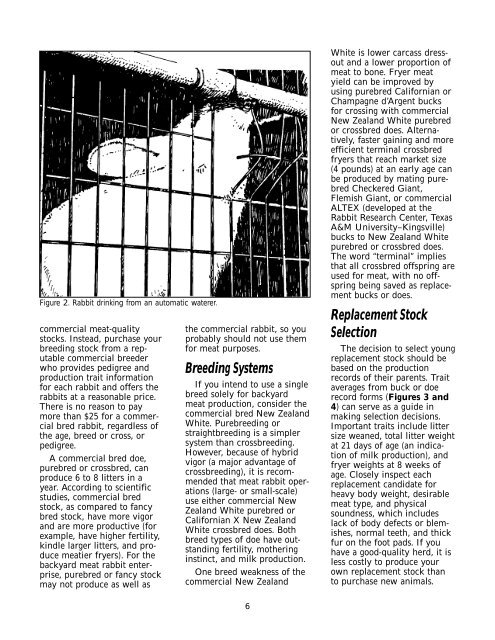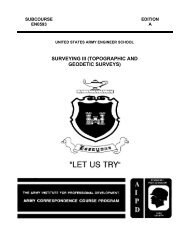Backyard Production of Meat Rabbits in Texas - World Rabbit ...
Backyard Production of Meat Rabbits in Texas - World Rabbit ...
Backyard Production of Meat Rabbits in Texas - World Rabbit ...
- No tags were found...
Create successful ePaper yourself
Turn your PDF publications into a flip-book with our unique Google optimized e-Paper software.
Figure 2. <strong>Rabbit</strong> dr<strong>in</strong>k<strong>in</strong>g from an automatic waterer.commercial meat-qualitystocks. Instead, purchase yourbreed<strong>in</strong>g stock from a reputablecommercial breederwho provides pedigree andproduction trait <strong>in</strong>formationfor each rabbit and <strong>of</strong>fers therabbits at a reasonable price.There is no reason to paymore than $25 for a commercialbred rabbit, regardless <strong>of</strong>the age, breed or cross, orpedigree.A commercial bred doe,purebred or crossbred, canproduce 6 to 8 litters <strong>in</strong> ayear. Accord<strong>in</strong>g to scientificstudies, commercial bredstock, as compared to fancybred stock, have more vigorand are more productive (forexample, have higher fertility,k<strong>in</strong>dle larger litters, and producemeatier fryers). For thebackyard meat rabbit enterprise,purebred or fancy stockmay not produce as well asthe commercial rabbit, so youprobably should not use themfor meat purposes.Breed<strong>in</strong>g SystemsIf you <strong>in</strong>tend to use a s<strong>in</strong>glebreed solely for backyardmeat production, consider thecommercial bred New ZealandWhite. Purebreed<strong>in</strong>g orstraightbreed<strong>in</strong>g is a simplersystem than crossbreed<strong>in</strong>g.However, because <strong>of</strong> hybridvigor (a major advantage <strong>of</strong>crossbreed<strong>in</strong>g), it is recommendedthat meat rabbit operations(large- or small-scale)use either commercial NewZealand White purebred orCalifornian X New ZealandWhite crossbred does. Bothbreed types <strong>of</strong> doe have outstand<strong>in</strong>gfertility, mother<strong>in</strong>g<strong>in</strong>st<strong>in</strong>ct, and milk production.One breed weakness <strong>of</strong> thecommercial New ZealandWhite is lower carcass dressoutand a lower proportion <strong>of</strong>meat to bone. Fryer meatyield can be improved byus<strong>in</strong>g purebred Californian orChampagne d’Argent bucksfor cross<strong>in</strong>g with commercialNew Zealand White purebredor crossbred does. Alternatively,faster ga<strong>in</strong><strong>in</strong>g and moreefficient term<strong>in</strong>al crossbredfryers that reach market size(4 pounds) at an early age canbe produced by mat<strong>in</strong>g purebredCheckered Giant,Flemish Giant, or commercialALTEX (developed at the<strong>Rabbit</strong> Research Center, <strong>Texas</strong>A&M University–K<strong>in</strong>gsville)bucks to New Zealand Whitepurebred or crossbred does.The word “term<strong>in</strong>al” impliesthat all crossbred <strong>of</strong>fspr<strong>in</strong>g areused for meat, with no <strong>of</strong>fspr<strong>in</strong>gbe<strong>in</strong>g saved as replacementbucks or does.Replacement StockSelectionThe decision to select youngreplacement stock should bebased on the productionrecords <strong>of</strong> their parents. Traitaverages from buck or doerecord forms (Figures 3 and4) can serve as a guide <strong>in</strong>mak<strong>in</strong>g selection decisions.Important traits <strong>in</strong>clude littersize weaned, total litter weightat 21 days <strong>of</strong> age (an <strong>in</strong>dication<strong>of</strong> milk production), andfryer weights at 8 weeks <strong>of</strong>age. Closely <strong>in</strong>spect eachreplacement candidate forheavy body weight, desirablemeat type, and physicalsoundness, which <strong>in</strong>cludeslack <strong>of</strong> body defects or blemishes,normal teeth, and thickfur on the foot pads. If youhave a good-quality herd, it isless costly to produce yourown replacement stock thanto purchase new animals.6

















